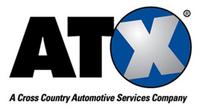Study Shows Reduced Levels of Driver Distraction Through ATX Group's In-vehicle Voice-Based Texting
 |
DETROIT--April 11, 2011: Interactive voice systems used for outbound text messaging reduced levels of driver distraction compared to manually texting on a smartphone according to a three-month study conducted by the Virginia Tech Transportation Institute (VTTI). The study was commissioned for connected vehicle (or telematics) services provider, ATX Group, of Dallas, which developed the in-vehicle voice technology system.
The study results will be presented by Dr. Thomas Schalk, ATX's vice president of Voice Technologies, at the SAE International 2011 World Congress event being held this week at the Cobo Center in Detroit. Schalk said the research was conducted in tandem with the company's development of voice-activated, voice-to-text and navigation system destination entry features that will be part of Hyundai Motor America's forthcoming Blue Link® telematics program.
ATX is a leading developer and integrator of customized, private-label connected vehicle services to global automobile manufacturers BMW, Hyundai, Lexus, Toyota, and Rolls-Royce Motor Cars.
Schalk will participate on a panel discussion, "The Challenges of Implementing New Technologies While Improving Safety", from 1:30-3:30 p.m. ET, on Wednesday, April 13, 2011, in the AVL Technology Leadership Center; other panel participants include representatives from Ford, Honda, Delphi and Denso.
"The VTTI study supports interactive voice applications for in-vehicle tasks rather than manual interaction and visual focus on the part of the driver, with the voice applications reducing those periods when hands are off the steering wheel and eyes are off the road," Schalk said.
Key conclusions from the VTTI research included:
- Eye glance data indicates that the ATX voice interface is safer than the equivalent manual interface for entering text messages. Subjects performed texting tasks manually using a smartphone, and the same texting tasks using the ATX speech interface. For manual texting, the number of eye glances to the mobile phone was measured to be 20 times the number of glances to the initiating button required for the outbound voice texting. Data also revealed that eye glance durations and the percentage of time a driver's eyes were off the road were shorter using the ATX voice interface as compared to comparable tasks performed using the handheld phone. Â Eye glance data similar to findings observed while texting were captured for destination entry tasks using the ATX voice interface, again supporting the goal of driver safety while entering text.
- Based on study participants' subjective responses, all handheld tasks required significantly more mental workload demand-- more than double in all cases on average -- than the ATX voice-based tasks. Similar findings were also recorded for frustration levels, a measurement that correlates with stress and annoyance in the performance of tasks.
- Drivers' self-perceived awareness of their surrounding environment was higher when engaged in voice-based tasks as compared to those completed manually. Reliance on voice-based systems didn't affect drivers' ability to complete the tasks they were asked to perform.
- Voice-based systems essentially erased the gap that exists between younger and older drivers in driving performance when using handheld devices.
- Participating drivers also found the ATX voice interfaces intuitive and easy to learn (96%) and felt the voice interfaces performed well (92%).
"While we can't conclude at this point that voice interfaces eliminate driver distraction, the data indicates that voice can certainly reduce the risk," Schalk said. "With the improvements in acoustically modeling the vehicle cockpit, extending language models, voice interface metrics, and simplified dialogue design, the ATX solution provides our clients with an exciting solution."
The study was conducted with 24 participants who were familiar with texting and owned a smartphone. Variables used to assess the handheld and voice systems included task duration, glance frequencies, glance durations, total glance time as a measure of percentage of eyes off road time, speed maintenance, steering variance, lane deviations and time out of lane, and subjective ratings of mental demand, frustration level and situation awareness.
Note: Blue Link® is a registered trademark of Hyundai Motor America Corporation
ABOUT ATX: With operations in Dallas-Fort Worth, Texas and offices in Dusseldorf, Germany and Paris, ATX (www.atxg.com) is one of the world's leading providers of connected vehicle services to global automobile manufacturers. ATX services, among the first to be launched in the consumer vehicle market back in 1996, are provided to vehicle owners through the brand names of its customers -- Toyota, Lexus Hyundai, BMW and Rolls Royce Motor Cars. Services by ATX provide enhanced safety, security and driving convenience to vehicle owners, and help automobile manufacturers and their affiliated dealerships use telematics data and multiple customer contact channels to reduce costs, enhance vehicle servicing, and more closely manage customer relationships and contacts with the vehicle through its lifetime.
ATX is a division of Cross Country Automotive Services, , a leading provider of roadside assistance programs in the U.S. on behalf of global automobile manufacturers and U.S. insurance carriers. Cross Country provides solutions for the nearly 6 million roadside service events experienced by their consumers each year. In addition, Cross Country provides accident scene management, vehicle release management and total loss screening services for insurance carriers, and customer care services for a number of automotive manufacturers.


